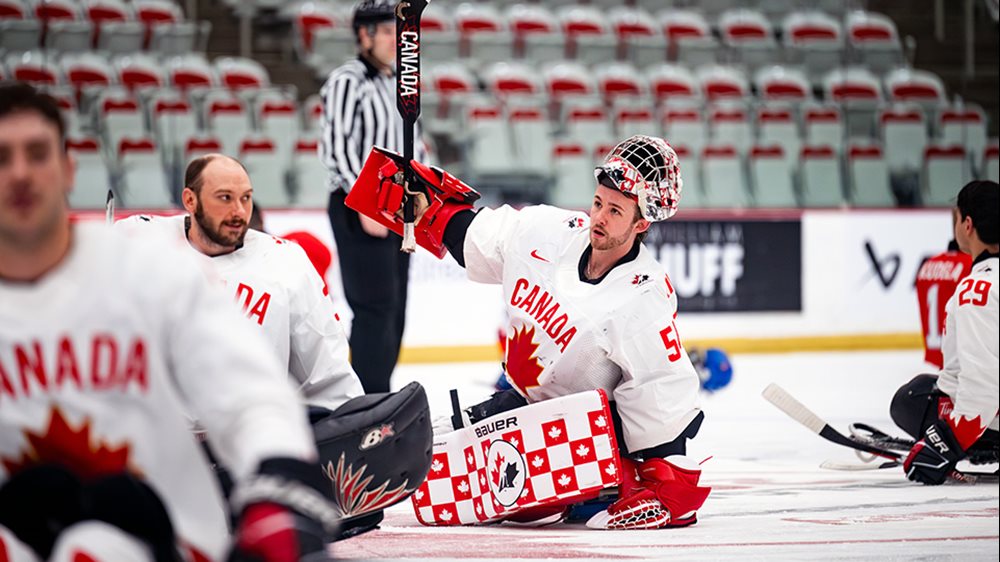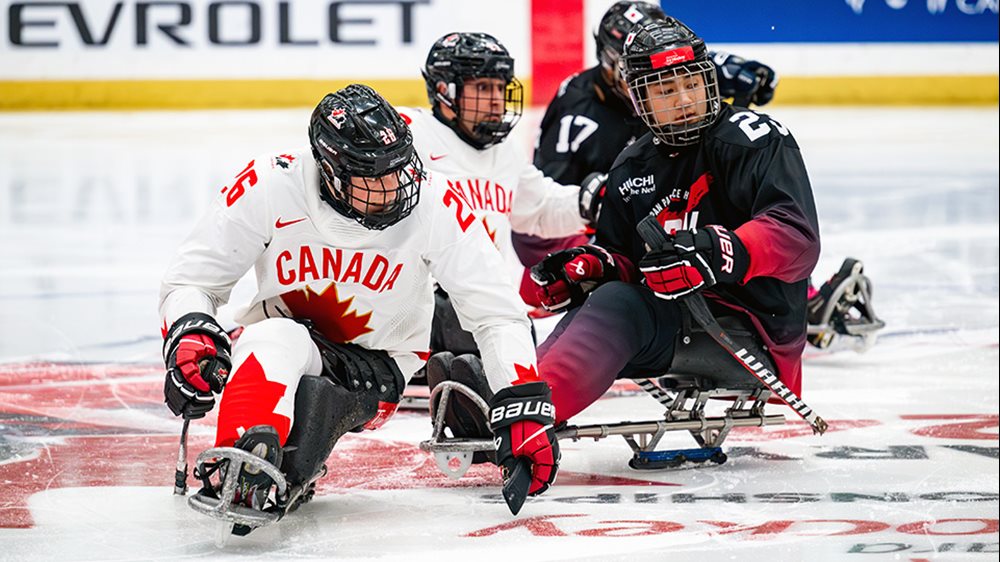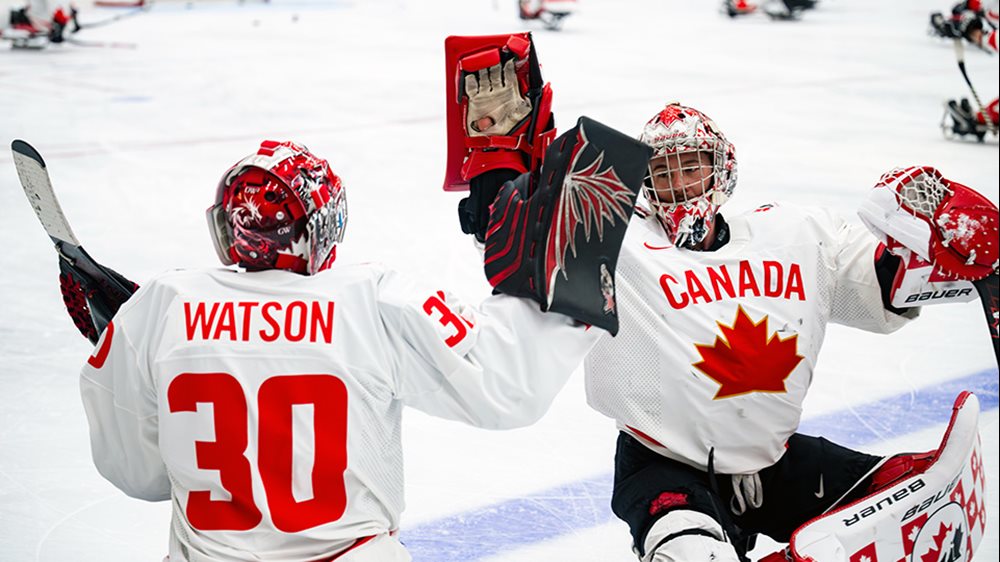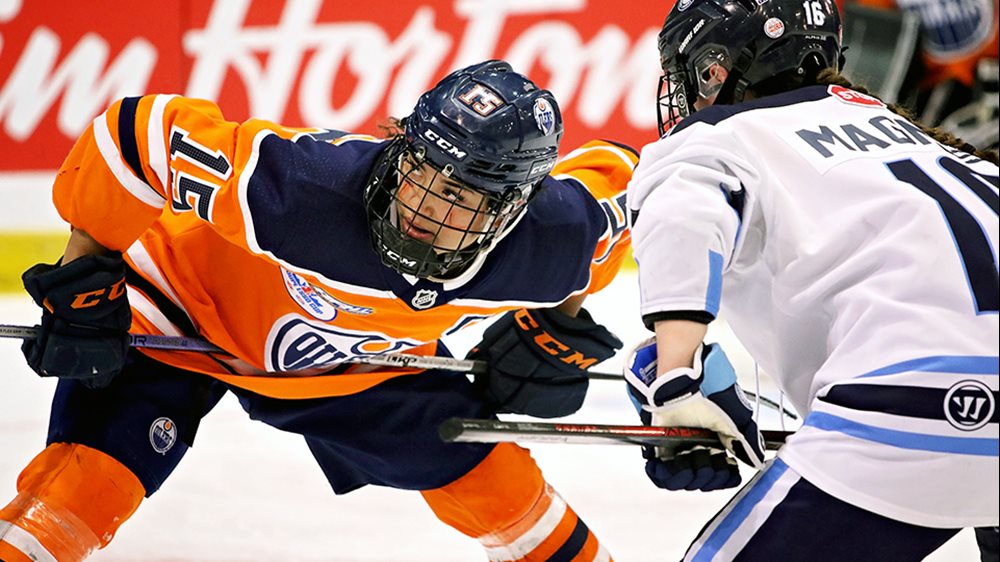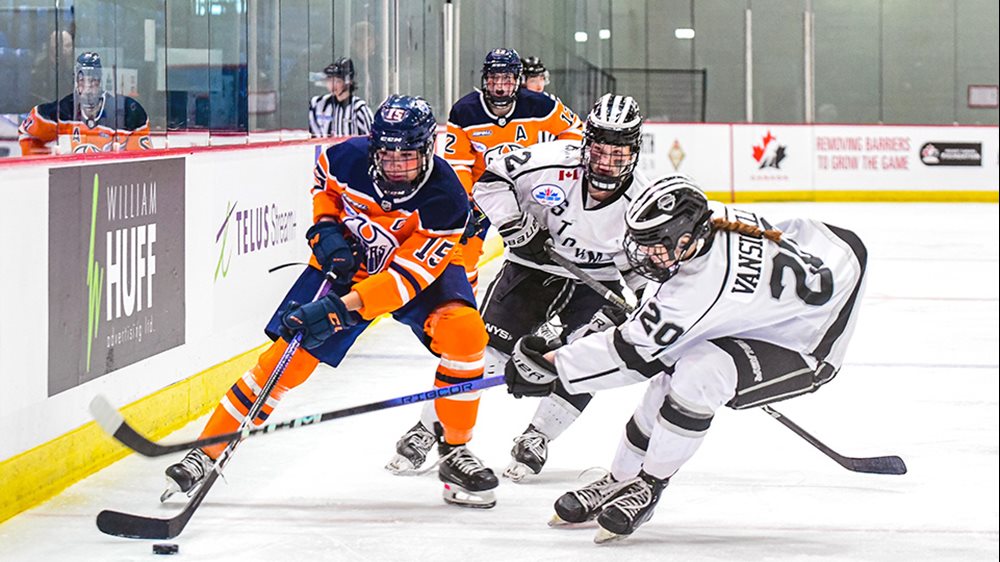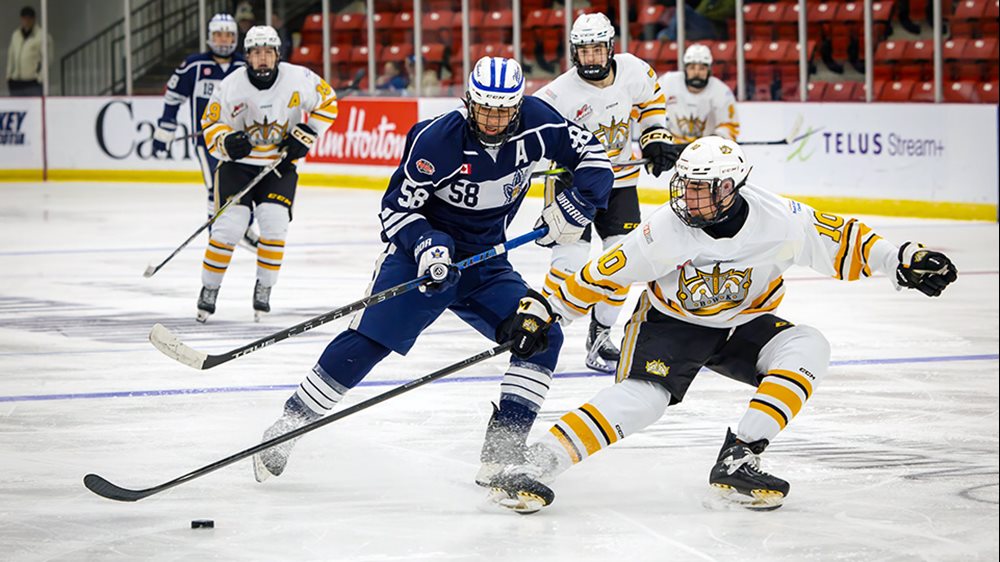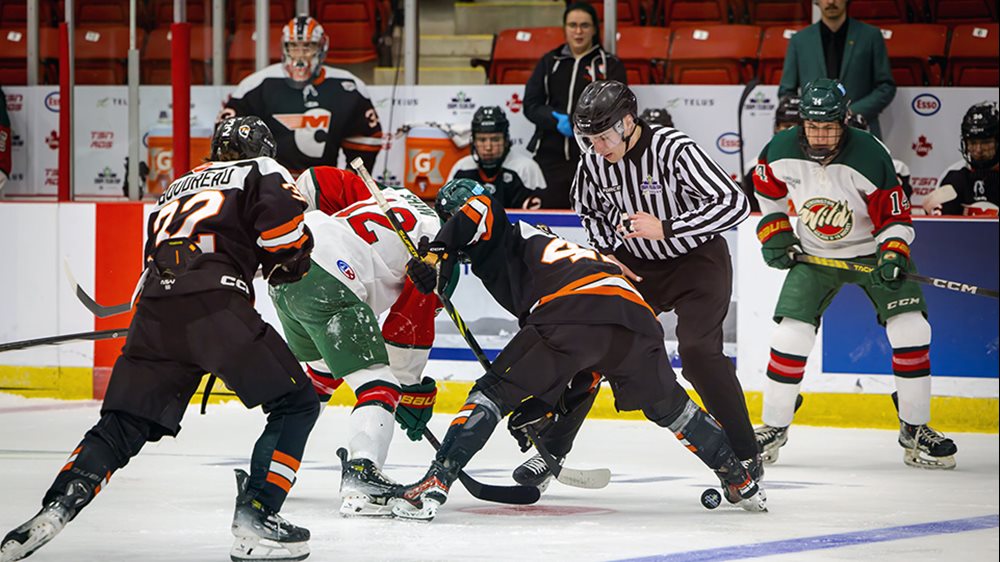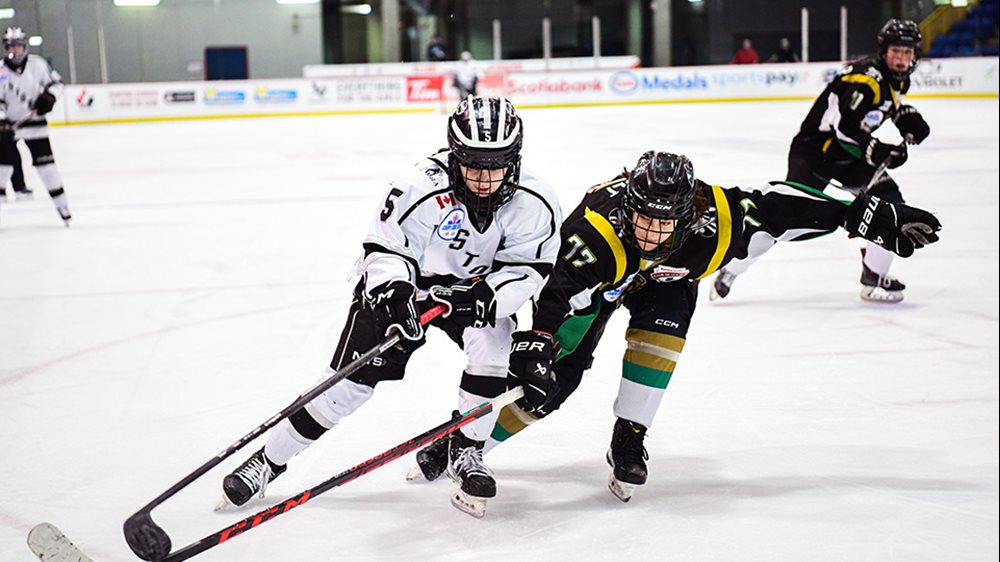
Active with Adam, presented by Jumpstart – Putting It All Together
Hockey Canada’s lead strength and conditioning coach shares tips and tricks to help players stay active at home and start preparations for next season
While the 2019-20 hockey season was forced to an early end due to the COVID-19 pandemic, there is no reason why the focus cannot begin to shift to next season.
One positive of social distancing is the opportunity for players of all ages and abilities to focus on improving away from the rink.
Off-ice training is just as important for hockey development as being on the ice. It allows for athletes to focus on other ways to enhance their on-ice skills.
Let’s break down the ways to improve at home to make sure players are ready to lace up the skates in the fall.
PART 1: SPEED | PART 2: POWER | PART 3: STRENGTH | PART 4: FLEXIBILITY | PART 5: CONDITIONING | PART 6: NUTRITION | PART 7: SKILL DEVELOPMENT | PART 8: MULTI-SPORT | PART 9: MENTAL PERFORMANCE
PART 10: PUTTING IT ALL TOGETHER
Over the last nine weeks, we have covered everything from speed and power to nutrition and mental performance. The key is now how can you consistently apply the principles as you prepare for next season. This will leave you with both a template you can use, along with a few challenges for the rest of the summer.
Feel free to tag @hockeycanada and #ActivewithAdam to share your progress!
SAMPLE TRAINING WEEK
Sunday: Multi-Sport Activity
Grab a tennis racquet, lacrosse stick or soccer ball and head to the local park to have fun and work on coordination. By learning other sports, you will continue to improve your athleticism.
Challenge #1: Learn to juggle a soccer ball – can you keep it in the air for 20 consecutive touches?
Challenge #2: Create an obstacle course and go through it while bouncing a tennis ball off a racquet.
Challenge #3: Try out three different sports this summer – and have fun!
Monday: Strength Training #1 (Pushing)
Creativity might be necessary for the weights and movements based on the available equipment.
CLICK HERE for the full workout.
Tuesday: Movement Training #1 (Speed, Agility, Quickness & Conditioning)
During the speed portion of the workout, remember to recover (2-5 minutes between sprints).
CLICK HERE for the full workout.
Challenge #1: Have a parent/friend time you over 20 metres – how many weeks does it take to get faster?
Wednesday: Strength Training #2 (Pulling) & Mental Performance Check-In
Creativity might be necessary for the weights and movements based on the available equipment.
After the workout, record and review your weekly and monthly goals.
CLICK HERE for the full workout.
Challenge #1: How many weeks does it take to do three more chin-ups than when you started?
Challenge #2: Set out to accomplish your weekly or monthly goal – did you achieve it?
Thursday: Movement Training #2 (Speed, Agility, Quickness & Conditioning)
During the speed portion of the workout, remember to recover (2-5 minutes between sprints).
CLICK HERE for the full workout.
Challenge #1: Time your conditioning runs – are you able to do more work over less time during shuttle runs?
Friday: Strength Training #3 (Lower-Body Speed/Power) & Nutrition
Creativity might be necessary for the weights and movements based on the available equipment.
CLICK HERE for the full workout and recipes.
Challenge #1: Add the new recipes from Emily Fulton to your weekly meal prep.
Challenge #2: Search for two new healthy post-workout meals that are high in protein.
Saturday: Recovery/Regeneration & Mental Performance Check-In
Congratulations on making it through the week! Select 4-5 of your favourite stretches and work on increasing your mobility and flexibility. If you’re feel sore and tired from the week, a short, dynamic movement session will help.
Challenge #1: Try out a meditation app – how long of a daily streak can you maintain?
Challenge #2: What is your favourite stretch? Snap a pic and tag us!

Sharing the passion
As one of the few Black players in her league, Willa Evans is excited to share her love of hockey with youth in Nova Scotia’s first NHL/NHLPA First Shift BIPOC program
As a young Black player growing up in Truro, N.S., Willa Evans struggled to find other youth that looked like her when she first got involved in the game.
“Growing up, my classmates were never like me. My teammates were never like me, and my coaches were never like me in that sense, being Black,” the 17-year-old says.
Now captain of her U18 AA team and the first Black captain of the Fundy Highland Female Hockey Association, she finds time to travel one hour each week to volunteer with Hockey Nova Scotia’s Black Youth Ice Hockey Program as a junior instructor. When she heard the province would be hosting its first BIPOC session as part of the NHL/NHLPA First Shift program, Evans jumped at the opportunity to volunteer.
“I’m really glad that the youth now have a chance to participate with people that are like them,” she says. “All the opportunities that these young kids have is very exciting for me to watch… with all of the different ways that they can get together and help the young youth get better together as the Black community.”
Evans wasn’t the only one who wanted to be involved with this program. There was an “overwhelming response” of volunteers, according to Dean Smith.
“I think it’s amazing,” says Smith, who is the chair of Hockey Nova Scotia’s Diversity and Inclusion Task Force. “The more people who are enrolled, the more members of the BIPOC community in dressing rooms, on the ice, in the officiating ranks, in the coaching ranks… it makes a huge difference. It’s role models for them to live up to.”
Along with the influx of volunteers, there’s also been lots of positive feedback from local hockey associations in the province, including requests to host their own NHL/NHLPA First Shift BIPOC program.
“We’ve had some comments about players wanting to play with kids that look like them, and that’s what these opportunities really do,” says Brad Taylor, technical director for Hockey Nova Scotia. “It’s the ‘see it is to believe it,’ really, so it’s great we’re able to do that and make that education and awareness piece within our ranks.”
“Every child, regardless of race [or] economic background, should have an opportunity to play [hockey] and love and enjoy, and that’s what we’re trying to create for these kids,” Smith adds.
Although it is a six-week program, the goal is for the hockey journey of the 30 participants to continue. Taylor says Hockey Nova Scotia is ready to support each participant and encourage them to sign up for minor hockey in the fall.
“It’s so important for these kids to continue to play,” he says. “Our goal would be to make sure we make it an easy transition.”
With dreams of becoming a coach and a teacher when she’s older, Evans is excited to get to know each of the young participants in the program.
“I want to teach young kids, so I love getting the experience of working with children,” she says. “I love their mentality. They’re always like ‘Yeah, I can do it,’ and it honestly makes me feel more confident being their coach and hearing them say that they can do it.”
National Women’s Team forward Sarah Nurse, who is on the ice in Beijing at her second Olympics, has been an inspiration to Evans throughout her hockey career. As a volunteer, she’s looking forward to the possibility of inspiring the lives of the program’s participants.
“To be one of those young kids’ role models… I don’t even know how to describe it. I’m just wowed by the fact that I’m old enough to be a role model,” she says. “I’m just absolutely excited to start working with these young kids.”
Over their six sessions together, Evans will have the opportunity to help develop the young participants as hockey players. But if there is one thing she hopes they will learn from the program, it’s her passion for the game.
“I just hope that they take from me the love of hockey and the amazing experiences they will get with hockey, and just them not giving up because times are hard,” she says.
“With us getting a whole bunch of opportunities for these young kids, I feel like they will want to help out when they’re older with their kids… I feel as if we are growing as the Black community in Nova Scotia and I feel like this is making us very much stronger.”

Active with Adam, presented by Jumpstart – Mental Performance
Hockey Canada’s lead strength and conditioning coach shares tips and tricks to help players stay active at home and start preparations for next season
While the 2019-20 hockey season was forced to an early end due to the COVID-19 pandemic, there is no reason why the focus cannot begin to shift to next season.
One positive of social distancing is the opportunity for players of all ages and abilities to focus on improving away from the rink.
Off-ice training is just as important for hockey development as being on the ice. It allows for athletes to focus on other ways to enhance their on-ice skills.
Let’s break down the ways to improve at home to make sure players are ready to lace up the skates in the fall.
PART 1: SPEED | PART 2: POWER | PART 3: STRENGTH | PART 4: FLEXIBILITY | PART 5: CONDITIONING | PART 6: NUTRITION | PART 7: SKILL DEVELOPMENT | PART 8: MULTI-SPORT
PART 9: MENTAL PERFORMANCE
This week, it’s about “motivation in a time of uncertainty” with Ryan Hamilton, a successful mental performance coach who has worked with the NHL’s Tampa Bay Lightning and has been part of the Team Canada staff at the last three IIHF World Junior Championships.
--
I am not winning the pandemic. Yes, some days motivation comes easy and I have gone for a run, completed hours of work and had a healthy meal before noon. On other days, I have hit snooze on my phone 10 times, watched Netflix mindlessly and blankly stared out the window before even giving a thought to doing much you would deem productive.
This article is about strategies to address a very real and normal reaction to what we are going through, not some “expert” saying motivation is easy if your head is in the right place. It is not. But with some of the strategies presented below in mind we can still find opportunities in our constraints, we can find a resiliency in this adversity, and we can realize that although many things are different the things that matter the most in this game and in our lives still matter the most.
UNCERTAINTY
Certainty is the breeding ground for action and well-being. If we know something is certain we can easily make it happen. If you had a definite date for when you were to resume play, daily training would be much easier. If training two hours per day was certain to make all your hockey dreams come true, you'd find a way to get it done.
Uncertainty is the breeding ground for indecision, poor decisions and excuse. Yet, no matter what situation we may find ourselves, certain or uncertain, the things that matter the most seem to always matter the most. The point of this message is to possibly provide you with a bit of guidance to help navigate those struggles effectively. Rather than focus on the questions, rely on the answers. Rather than wonder what might happen in the future, know what is possible today. The bedrock of all elite performance is preparation, a willingness to grow and a resounding commitment to your goals.
PHYSICAL ACTIVITY
Obviously, being active is a part of your daily life as an athlete. What you may not realize (because you are always engaged with it) is the role that being active has on your psychological well-being. With the various restrictions that have been added to our lives, working out or training may look like something less than ideal. But just because things aren't optimal doesn't mean they aren't worth doing.
With creativity and commitment, we can find a way to approximate our best training conditions. We can find a way when others might find an excuse. It is not just about getting a workout in; it is also about immersing yourself in it and enjoying it. It is about seeking out accomplishments even when times are uncertain. Take joy in continuing to push your body, to push your mind, to push your boundaries.
We will return to play eventually. You will walk into a hockey school or a training camp. You will show up at the rink for your first game of a new season. Those days are coming. You will not regret any of the positive work you are doing now when they do. Stay fit, stay well and make the most of your situation.
MOTIVATION TIPS
1. Write It Down: Keep track of something you want to increase in your life and log it every single day. This could be something as simple as push-ups per day or kilometres biked.
2. Goals: Set a weekly or monthly goal of something you want to do (minutes working on shot, time spent on mobility exercises, number of kilometres run). Attach a small reward to achieving that goal.
3. Priorities: Make the things you want to do each day depend on the things you need to do. Do the difficult things early.
4. Joy, Not Dread: Pair the “work” you need to do with something you enjoy (a new playlist played a little extra loud, run in your favourite park instead of just grinding it our in your neighborhood).
5. Pull Others In: Workout with someone else – even virtually. Keep each other accountable. Celebrate success.
6. Post It: Post your weekly training plan in a place for everyone to see and encourage you.
7. Perspective: Think about the things in your schedule in terms of why you want to get them done versus why you have to get them done. ‘Have to’ thinking creates anxiety, ‘want to’ thinking reminds you of your passions.
8. Serve Your Values: Try to choose three small things every day that will work in service of things you value. For example – one that gives you a sense of achievement, one that makes you feel healthy and one that makes you feel connected to others. Even if you don’t manage much else, you can feel good knowing you did these three things.

Active with Adam, presented by Jumpstart – Multi-Sport
Hockey Canada’s lead strength and conditioning coach shares tips and tricks to help players stay active at home and start preparations for next season
While the 2019-20 hockey season was forced to an early end due to the COVID-19 pandemic, there is no reason why the focus cannot begin to shift to next season.
One positive of social distancing is the opportunity for players of all ages and abilities to focus on improving away from the rink.
Off-ice training is just as important for hockey development as being on the ice. It allows for athletes to focus on other ways to enhance their on-ice skills.
Let’s break down the ways to improve at home to make sure players are ready to lace up the skates in the fall.
PART 1: SPEED | PART 2: POWER | PART 3: STRENGTH | PART 4: FLEXIBILITY | PART 5: CONDITIONING | PART 6: NUTRITION | PART 7: SKILL DEVELOPMENT
PART 8: MULTI-SPORT
While it can be tough being away from the rink and off the ice for such a long period of time, this forced time out of your skates will allow you to turn your attention to the participation of other sports.
The term multi-sport athlete means that through the developmental years or stages of long-term athlete development (active start, FUNdamentals, learn to train), athletes are exposed to many different sports instead of focusing all of their time on a single sport.
There are numerous benefits to multi-sport exposure for athletes, including:
-- improved movement abilities (physical literacy) -- increased physical fitness -- skill transfer across sports (hand-eye coordination) -- less chance of developing an over-use injury, which requires time away from their specific sport -- less likely to develop burn-out, which causes an athlete to quit their sport later in life
A great way to develop physical literacy is to challenge yourself in different ways, using different methods. Challenge your hand-eye coordination with a tennis racket or lacrosse stick next time you want to play catch or shoot pucks. Increase the intensity of your agility and speed sessions while playing tag with a sibling or parent. Multi-sport participation can also include learning new physical skills like juggling with your hands or feet (like a soccer player).
Learning and engaging in new and challenging sports are an excellent way to pass the time indoors – and to add some fun new activities into your daily training.

Active with Adam, presented by Jumpstart – Skill Development
Hockey Canada’s lead strength and conditioning coach shares tips and tricks to help players stay active at home and start preparations for next season
While the 2019-20 hockey season was forced to an early end due to the COVID-19 pandemic, there is no reason why the focus cannot begin to shift to next season.
One positive of social distancing is the opportunity for players of all ages and abilities to focus on improving away from the rink.
Off-ice training is just as important for hockey development as being on the ice. It allows for athletes to focus on other ways to enhance their on-ice skills.
Let’s break down the ways to improve at home to make sure players are ready to lace up the skates in the fall.
PART 1: SPEED | PART 2: POWER | PART 3: STRENGTH | PART 4: FLEXIBILITY | PART 5: CONDITIONING | PART 6: NUTRITION
PART 7: SKILL DEVELOPMENT
Two of the best places to incorporate skill work into daily strength training is to add them as elements within your warm-up or during rest breaks.
Find creative ways to include your stick with your warm-up – 3-5 minutes of skill work in the driveway before beginning the dynamic portion is a good way to increase the heart-rate and ramp up the intensity and energy levels!
Another way to get those puck touches during a training session is to turn rest breaks into "active recovery" sessions. The time between exercises or sets can vary from 30 seconds to three minutes, depending on the training plan (shorter rest = more endurance, more rest = strength/power focus). Being active during rest breaks with stick-handling or shooting drills is a easy way to work on both skills and fitness during sessions.
Skill specific training can be done in three simple ways, all of which will enhance overall athleticism and physical literacy.
Daily Training Routine
Skill work can be built into any daily routine by adding skill-specific training as a warm-up or cool-down. As a warm-up, stick-handle a ball or puck using any number of skills for range of motion, quickness or agility. As a cool-down after a run, set up a shooting station with 100 pucks using a variety of skills – wrist shot, backhand, change the shooting angle or quick release.
Alternating Skills Days
It will be beneficial to alternate training days by doing skill-specific work off the ice every second day. Incorporate skill work by creating a series of puck- or ball-handling exercises, followed by a series of hand-eye coordination skills and shooting skills. These can still be done with intensity to get the heart-rate up, and repetition will compliment a full off-ice training program.
Training Circuits
Training circuits can be a fun way of breaking up the monotony of traditional training; create 10-15 stations that allow for a series of skills to be worked on. For example:
Station 1 – Balance Station 2 – Power Station 3 – Puck/Ball Handling Station 4 – Agility Station 5 – Hand-Eye Coordination Station 6 – Upper-Body Strength Station 7 – Shooting (Forehand) Station 8 – Lower-Body Strength Station 9 – Rest/Hydration Station 10 – Coordination (Stick-handling with one hand/tossing a tennis ball with the other) Station 11 – Shooting (Backhand) Station 12 – Sprints Station 13 – Shooting (Quick Release) Station 14 – Core Strength/Yoga Moves Station 15 – Rest/Hydration
Repeat the circuit 2-3 times and change up some of the activities in each circuit.
The main goal is to make workouts fun and adaptable to work on the physical components to meet age-appropriate goals while also working on skill components that will complement off-ice training to be more prepared when it comes time to get back on the ice. Remember, proper warm-ups and cool-downs should also be part of each training session.

Active with Adam, presented by Jumpstart – Nutrition
Hockey Canada’s lead strength and conditioning coach shares tips and tricks to help players stay active at home and start preparations for next season
While the 2019-20 hockey season was forced to an early end due to the COVID-19 pandemic, there is no reason why the focus cannot begin to shift to next season.
One positive of social distancing is the opportunity for players of all ages and abilities to focus on improving away from the rink.
Off-ice training is just as important for hockey development as being on the ice. It allows for athletes to focus on other ways to enhance their on-ice skills.
Let’s break down the ways to improve at home to make sure players are ready to lace up the skates in the fall.
PART 1: SPEED | PART 2: POWER | PART 3: STRENGTH | PART 4: FLEXIBILITY | PART 5: CONDITIONING
PART 6: NUTRITION
This week, Active with Adam becomes Fueling with Fulton with special guest Emily Fulton, a registered dietician and sports nutritionist who won gold and silver with Canada’s National Women’s Under-18 Team at the IIHF World Women’s U18 Championship in 2010 and 2011.
No training program is complete without the proper nutrition to support it.
Hard training sessions naturally cause muscles to break down, resulting in muscle soreness. It is a natural process that allows the body to repair and rebuild muscles. Protein is the building block of muscle and without adequate protein (chicken, yogurt, eggs, tofu, etc.) the body can’t repair its muscles. In the end, the hard work doesn’t lead to improvement.
Muscle protein synthesis, a fancy term for building muscle, is optimized when the body has small “protein pulses” throughout the day. To be more precise, the body’s ability to build muscle is maximized when we consume 0.25 grams of protein per kilogram of body-weight every 3-4 hours. In simple terms: If you weigh 60 kg (132 lbs) it would require 15 grams of protein at each meal or snack. Unfortunately, many forget about protein with breakfast and tend to spread the protein between lunch and dinner.
Instead of jumping right to an 8 oz steak for breakfast, there are simple ways to include protein in the morning. Try a Greek yogurt parfait, eggs, tofu scramble, nuts or protein powder smoothie. Or try a couple of go-tos – Mini Frittatas and Protein Pancakes!
RECIPES
Mini Frittatas
- Spread three-quarters of a cup of your favourite chopped vegetables into 12 greased muffin tins.
- In a large bowl, whisk together 10-12 eggs, salt and pepper to taste, and a splash of milk. Pour over the chopped veggies to fill the muffin tins three-quarters full.
- Bake at 350°F for 20-25 minutes.
- Allow to cool and enjoy!

Tip: Store the protein-packed frittatas in the fridge for five days or in the freezer for two months.
Protein Pancakes
- Combine a half-cup of oats, three eggs (or a half-cup of egg whites), a half-cup of cottage cheese, one large banana, one tsp of baking powder and one tsp of vanilla extract in a blender or food processor. Blend until the ingredients are evenly combined or until the oats are your desired consistency.
- Cook the pancakes (recipe yields eight) over medium heat, flipping them over when the underside has turned a golden brown.
- Store in the fridge or freezer and pop in the toaster throughout the week.
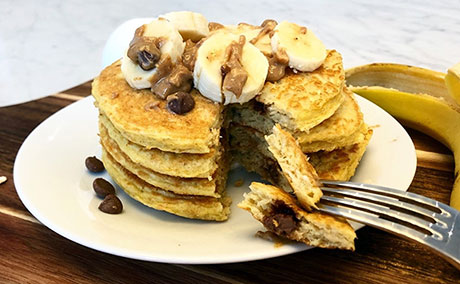
Tip: Personalize your pancakes with your favourite toppings, like blueberries, chocolate chips or peanut butter.
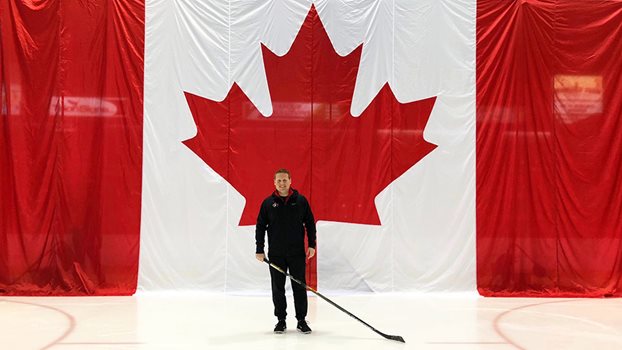
Active with Adam, presented by Jumpstart – Conditioning
Hockey Canada’s lead strength and conditioning coach shares tips and tricks to help players stay active at home and start preparations for next season
While the 2019-20 hockey season was forced to an early end due to the COVID-19 pandemic, there is no reason why the focus cannot begin to shift to next season.
One positive of social distancing is the opportunity for players of all ages and abilities to focus on improving away from the rink.
Off-ice training is just as important for hockey development as being on the ice. It allows for athletes to focus on bio-motor abilities (speed, power, strength, flexibility, conditioning) that will enhance their on-ice skills.
Let’s break down the ways to improve these specific areas at home to make sure players are ready to lave up the skates in the fall.
PART 1: SPEED | PART 2: POWER | PART 3: STRENGTH | PART 4: FLEXIBILITY
PART 5: CONDITIONING
One of the most important physical abilities is conditioning. The ability to work hard and then recover between shifts is key to maintaining your strength and power throughout the course of a shift or game. As you become better conditioned, athletic ability can be easier expressed and things become easier on the ice. Athletes who have a strong baseline of conditioning also recover faster between games and during travel. There are a lot of different ways to train your conditioning; here are a few sessions you can use to make sure you are ready when the puck is dropped.
EXERCISES
Aerobic Capacity: Timed Circuit
Set a timer for 12 minutes and work at a consistent pace for the entire time.
- Bodyweight Squat (10)
- Push-Up (10)
- Single-Leg Toe Touch (10 each side)
- Bear Crawl (5 steps each side – forward and backward)
- Lateral Lunge (10 each side)
- Mountain Climber (10 each side)
Aerobic Power: Run-Walk Intervals
Five-minute dynamic or running-based warm-up.
Two-minute sprint/run (100% effort) followed by a four-minute walk (aim for five sets per session).
Anaerobic Capacity: Shuttle Run
Set cones up at 5m – 10m – 15m – 20m.
Sprint out and back, touching each cone and sprinting back to the start line. Time yourself and rest three times the total time it took you to perform the set (if it took you 30 seconds, rest 90 seconds). Perform two sets of five reps to start, with four-minute break between the reps. Add one rep each week to a max of eight, then begin to add an extra cone each five metres.

Active with Adam – Flexibility
Hockey Canada’s lead strength and conditioning coach shares tips and tricks to help players stay active at home and start preparations for next season
While the 2019-20 hockey season was forced to an early end due to the COVID-19 pandemic, there is no reason why the focus cannot begin to shift to next season.
One positive of social distancing is the opportunity for players of all ages and abilities to focus on improving away from the rink.
Off-ice training is just as important for hockey development as being on the ice. It allows for athletes to focus on bio-motor abilities (speed, power, strength, flexibility, conditioning) that will enhance their on-ice skills.
Let’s break down the ways to improve these specific areas at home to make sure players are ready to lave up the skates in the fall.
PART 1: SPEED | PART 2: POWER | PART 3: STRENGTH
PART 4: FLEXIBILITY
Flexibility is important for all sports, including hockey. It allows your body to get into certain positions and can work to increase the range of motion. This allows you to skate lower, which in turn will allow you to increase your power while skating. Being flexible isn’t just for goalies! Important areas to focus on include the hamstrings, glute muscles and hip flexors. Here is a simple stretching routine that you can follow on days you are not training (recovery) or following any of previous training sessions.
EXERCISES
Hip Flexor Stretch with Reach and Rotation: Get into a half-kneeling position, making sure your hip is stacked over the down knee. Reach your hands forward, with your fingers pointed down (think Spiderman shooting webs). Rotate slightly towards the down hip (think arms at 12 o’clock and 3 o’clock), then lean (side bend) away from the down leg. Hold for 30 seconds each side.
90/90 Hip Stretch: Sit on one hip, with both legs positioned 90 degrees in front of and behind you (think 90 degrees at ankle, knee and hip). Sitting up tall, squeeze your abs and try to be straight and tall through your upper body, slightly pressing your front leg into the ground. Hold for 30 seconds with each leg in the front position.
Reverse Nordic (Active Stretch): Set up in a tall kneeling position (both knees down), with your toes flat on the ground behind you. Maintain a tall-and-tight posture, with your hips in a neutral position. Keeping your shoulders over your hips, lean as far back as you can, making sure you are not just moving your shoulders back. Lean as far back as you can before you lose your posture, then return to the starting position. It can help to maintain proper posture by holding a broomstick behind your back and maintaining five points of contact (head, top hand, upper back, lower hand, butt) on the stick. Perform 10 of these lean backs.

Active with Adam – Strength
Hockey Canada’s lead strength and conditioning coach shares tips and tricks to help players stay active at home and start preparations for next season
While the 2019-20 hockey season was forced to an early end due to the COVID-19 pandemic, there is no reason why the focus cannot begin to shift to next season.
One positive of social distancing is the opportunity for players of all ages and abilities to focus on improving away from the rink.
Off-ice training is just as important for hockey development as being on the ice. It allows for athletes to focus on bio-motor abilities (speed, power, strength, flexibility, conditioning) that will enhance their on-ice skills.
Let’s break down the ways to improve these specific areas at home to make sure players are ready to lave up the skates in the fall.
PART 3: STRENGTH
There are a lot of different (and creative ways) to build strength. The key is to think of how the body moves – perform exercises that focus on pushing, pulling, hinging (bending over) and rotating. Perform exercises that are bilateral (both sides together, like a squat) or unilateral (one side, like a lunge).
Exercises can be isometric (where you hold a position), eccentric or negative-based (slowly lower into a position), or you can move through the whole range of motion under control. Be creative in the exercises you select and how you can add weight or make the exercises more challenging. Filling a backpack with heavy objects (textbooks, canned food) can be an easy way to make exercises harder!
EXERCISES
Here is a simple bodyweight circuit:
1. Squat to Reverse Lunge (8 reps per side) 2. Bent Over Row (12 reps per side) 3. Prone Plank (30-second hold) 4. Push-Up to Shoulder Tap (5 reps per side – 10 total) 5. Towel Hamstring Leg Curl (12 reps) 6. Side Plank with Hip Raise (10 reps per side)
Rest 60 to 90 seconds and repeat circuit 3-4 times.

Active with Adam – Power
Hockey Canada’s lead strength and conditioning coach shares tips and tricks to help players stay active at home and start preparations for next season
While the 2019-20 hockey season was forced to an early end due to the COVID-19 pandemic, there is no reason why the focus cannot begin to shift to next season.
One positive of social distancing is the opportunity for players of all ages and abilities to focus on improving away from the rink.
Off-ice training is just as important for hockey development as being on the ice. It allows for athletes to focus on bio-motor abilities (speed, power, strength, flexibility, conditioning) that will enhance their on-ice skills.
Let’s break down the ways to improve these specific areas at home to make sure players are ready to lace up the skates in the fall.
PART 2: POWER
It is no secret that power is important for hockey. Power allows players to skate faster, shoot harder and win puck battles. It can be trained through the use of plyometrics (a training method which often requires athletes to jump, hop, skip and/or bound). Static jumps (pausing and holding the down position of a jump) are useful for hockey players to increase leg power due to the unique skating position. When skating, leg power needs to be generated from this bent-knee-and-hip position.
EXERCISES
Static Squat Jump: With feet shoulder-width apart, squat down and hold this down position for three seconds before exploding in the air as hard as you can. Land softly and athletically, and then reset. Perform five jumps per set. Aim for 3-4 sets per session.
Split Squat Jump with Switch and Stick: Start this jump in a lunge position. Explode into the air, switching your front and back legs while in the air. Stick your landing (and pause), before performing another jump. Perform three jumps per leg (six total jumps) per set. Aim for 3-4 sets per session.
For more information: |
- <
- >
















